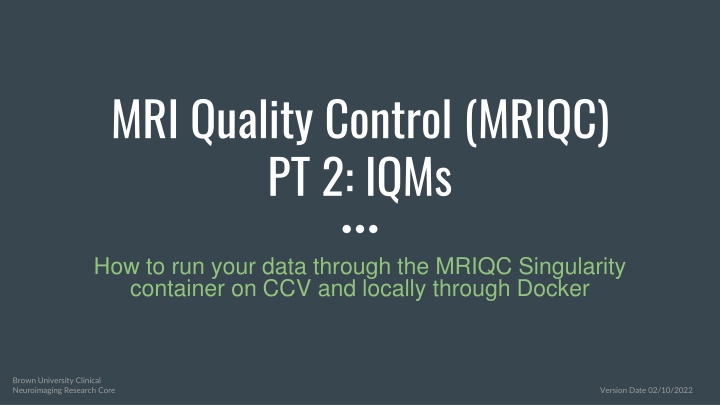
Understanding MRIQC: Image Quality Metrics and IQMs
Explore how to evaluate and improve MRI image quality using IQMs through the MRIQC tool. Learn about structural and functional IQMs, measures based on information theory, and noise measurement techniques in MRI imaging. Discover the importance of assessing signal-to-noise ratio, contrast-to-noise ratio, and other key metrics for quality control in neuroimaging research.
Download Presentation

Please find below an Image/Link to download the presentation.
The content on the website is provided AS IS for your information and personal use only. It may not be sold, licensed, or shared on other websites without obtaining consent from the author. If you encounter any issues during the download, it is possible that the publisher has removed the file from their server.
You are allowed to download the files provided on this website for personal or commercial use, subject to the condition that they are used lawfully. All files are the property of their respective owners.
The content on the website is provided AS IS for your information and personal use only. It may not be sold, licensed, or shared on other websites without obtaining consent from the author.
E N D
Presentation Transcript
MRI Quality Control (MRIQC) PT 2: IQMs How to run your data through the MRIQC Singularity container on CCV and locally through Docker Brown University Clinical Neuroimaging Research Core Version Date 02/10/2022
MRIQC Mechanisms Image Quality Metrics (IQM) No-reference metric of data quality Structural IQM Categories Signal and noise comparisons Information theory measures Mechanical artifacts Functional IQM Categories Spatial artifact detection Temporal stability Links to more information about IQMs found on the References slide (slide 14)
Measures Based on Information Theory & Spatial Info Use information theory to evaluate the spatial distribution of information EFC Entropy-focus criterion Indicates ghosting and blurring caused by head motion Lower values are better indicate less head motion FBER Foreground-background energy ratio The mean energy of image values within the head relative to the outside of the head Higher values are better indicates better signal inside the brain SSTATs Several summary statistics see MRIQC reporting template for more details Includes Mean, Stan. Dev., 5-95% percentiles, and kurtosis of background, Cerebrospinal Fluid (CSF), and White and Grey Matter
Structural IQM: Noise Measurement pt 1 Characterize the impact of noise and evaluate the fitness of a noise model CJV Coefficient of joint variation of White Matter (WM) and Grey Matter (GM) Higher values of this mean heavy head motion and large INU artifacts For INU, please refer to Slide 8 Lower values are better less indicative of head motion CNR Contrast-to-noise ratio Evaluates how separated the tissue distributions of grey matter and white matter are Higher values are better indicates better separation of tissue
Structural IQM: Noise Measurement pt 2 SNR SNRD Signal-to-noise ratio Signal of the image to the background noise of the image. Higher is better indicates less noise Dietrich s Signal to Noise Ratio Signal of the image to the background noise that includes a correction factor for the standard deviation of air Higher is better indicates less noise QI2 Mortamet s quality index 2 Goodness of fit of a noise model into the background Lower is better indicates less corruption by artifacts
Structural IQM: Measures Targeting Specific Artifacts Looks for the presence and impact of certain artifacts INU Intensity nonuniformity Describes the inhomogeneity of the magnetic field Values should be around 1.0 indicates less motion and less inu in the magnetic field QI1 Mortament s first quality index Proportion of voxels corrupted by artifacts normalized by the number of voxels in the background Smaller values are better indicate less corruption by artifacts WM2MAX White-matter to maximum intensity ratio The median intensity within the WM mask over the 95% percentile of the full intensity distribution measures for hyperintensities Values should be around the interval [0.6, 0.8] indicates ideal ratio of WM brightness
Structural IQM: Other Measures - pt. 1 Characterize the statistical properties of tissue distributions, volume overlap tissues, and the sharpness/blurriness of the images FWHM Full-width half-maximum An estimation of image blurriness Lower values are better indicates less blurriness ICVs Intracranial volume fractions of CSF, GM, and WM Proportion of each tissue type in the brain Normal values fall around 20%, 45%, and 35% for cerebrospinal fluid (CSF), WM, and GM respectively
Structural IQM: Other Measures - pt. 2 rPVE Residual partial volume effect Describes the tissue-wise of partial volumes that fall within the range of 5%-95% of the pixel s total volume. Smaller values are better indicate less partial voluming and better spatial resolution TPMs Tissue probability maps Overlaps the image and corresponding established maps for comparison Higher values are better indicates better overlap between the two maps
Functional IQM: Measures for the Temporal Information DVARS D = Temporal Derivative of Time Courses; Vars= Root Mean Square (RMS) Variance Over Voxels Indexes the rate of change of BOLD signal across the entire brain at each frame of data Lower is better indicates less motion and slower rates of change GCOR Global correlation Brain-wide average correlation over all possible combinations of voxel time series Lower is better indicates less correlation between motion and BOLD time series tSNR Temporal Signal to Noise Ratio Ratio between mean signal of time series and the temporal standard deviation Higher is better indicates better signal and time course stability
Functional IQM: Measures for artifacts and other Framewise Displacement Quantifies head motion from each time frame to the next Includes the number and percentage of timepoints with an FD above 0.20mm and mean FD of the run Lower is better indicates less head motion GSR Ghost to signal ratio The mean signal intensity in areas areas where ghosting is apparent relative to the signal intensity with respect to the brain Lower is better indicates less ghosting
Functional IQM: Measures for Artifacts and Other - Pt. 2 AOR AFNI s (Analysis of Functional NeuroImages Software) outlier ratio The mean fraction of outliers in each volume Flags images with lots of voxels in the time series that are outliers Lower is better indicates less outliers AQI AFNI s quality index Mean distance between each volume and the median volume of the time series Screens for random abnormal images in a time series Values close to 0 are better indicates that the time series is closer to the norm Dummy A number of volumes in the beginning of the fMRI time series identified as non-steady state
Helpful Links https://mriqc.readthedocs.io/en/stable/about.html https://rpubs.com/sarenseeley/bids-fmriprep-mriqc Woodard & Carley-Spencer, 2006 MRIQC.org, 2020 Jarrahi & Mackey, 2018 Esteban et al., 2019
References Esteban, O., Birman, D., Schaer, M., Koyejo, O. O., Poldrack, R. A., & Gorgolewski, K. J. (2017). MRIQC: Advancing the automatic prediction of image quality in MRI from unseen sites. PLOS ONE, 12(9). https://doi.org/10.1371/journal.pone.0184661 Esteban, O., Markiewicz, C. J., Blair, R. W., Moodie, C. A., Isik, A. I., Erramuzpe, A., Kent, J. D., Goncalves, M., DuPre, E., Snyder, M., Oya, H., Ghosh, S. S., Wright, J., Durnez, J., Poldrack, R. A., & Gorgolewski, K. J. (2019). fMRIPrep: a robust preprocessing pipeline for functional MRI. Nature methods, 16(1), 111 116. https://doi.org/10.1038/s41592-018-0235-4 Jarrahi, B., & Mackey, S. (2018). Characterizing the effects of MR image quality metrics on intrinsic connectivity brain networks: A multivariate approach. Annual International Conference of the IEEE Engineering in Medicine and Biology Society. IEEE Engineering in Medicine and Biology Society. Annual International Conference, 2018, 1041 1045. https://doi.org/10.1109/EMBC.2018.8512478

